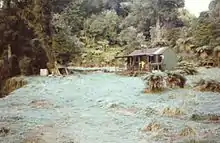Whirinaki Te Pua-a-Tāne Conservation Park
Whirinaki Te Pua-a-Tāne Conservation Park is a publicly accessible conservation park in the North Island of New Zealand. The park is centered on the town of Minginui and part of the eastern boundary flanks Te Urewera. The Whirinaki Forest is one of the world's last prehistoric rainforests.[1]
| Whirinaki Te Pua-a-Tāne Conservation Park | |
|---|---|
 Arohaki Lagoon | |
 Whirinaki Te Pua-a-Tāne Conservation Park | |
| Location | North Island, New Zealand |
| Nearest town | Rotorua |
| Coordinates | 38°40′S 176°41′E |
| Area | 65,000 hectares (160,000 acres) |
| Governing body | Department of Conservation |
The Department of Conservation is responsible for administering the 562 km2 (217 sq mi)[2] park jointly with the local iwi, Ngāti Whare. Tramping is a popular recreation in the park and there is a network of 175 km of tracks and 9 huts that are used for this purpose.[3]

The unsealed River Road provides access to a carpark and the starting point of many walks. Short walks lead through native bush to Waiatiu Falls, Arohaki Lagoon, Te Whaiti-Nui-A-Toi Canyon, and Whirinaki Falls, respectively. The rain-fed Arohaki Lagoon is often alive with Southern Bell Frogs. Longer tramping tracks connect several huts and two other access roads.
The forests were a focus of protests over logging in the 1970s and 80s. Large parts of the park remain covered in native podocarp forest featuring rimu, totara, kahikatea, matai (Prumnopitys taxifolia), and miro. Some higher parts contain beech forest. The forest supports a wide range of birds, some of which are endangered.
Whirinaki is the location of Nga Hua a Tane, a radical place based research program on rainforests and the ecosystem services they provide to support life on our planet, led by the local school, Te Kura Toitu o Te Whaiti Nui-a-Toi and its community.
In 2010, a co-governance agreement was signed with Ngati Whare as part of a treaty settlement. As part of the settlement, the New Zealand government apologised for past injustices and acknowledged the park was integral to Ngati Whare's cultural identity and wellbeing. The settlement provided for a joint Ngati Whare and Crown regeneration project, which aimed to regenerate 640ha of exotic pine adjacent to the park back to indigenous podocarp forest, with David Bellamy as patron. The park's name was changed from Whirinaki Forest Park to Whirinaki Te Pua-a-Tāne Conservation Park. Whirinaki Te Pua-a-Tāne means the abundance of Tāne.[4][5][6]
Moerangi Mountain Bike Track
The Moerangi Track is a dual purpose track for mountain bikers and trampers located in the Whirinaki Te Pu-a-Tane Conservation Park.
The track is 35km of Grade 3 (intermediate) mountain bike track and takes around 5 to 6 hours to complete for someone with medium to high level of fitness.
Situated along the track are three huts, Skips, Rogers and Moerangi. All three spots are a good stopping point for riders or a place to stay on an overnight ride.[7]
See also
- Tāne, God of forests and birds in Māori mythology.
- Conservation parks of New Zealand
- Conservation in New Zealand
Further reading
- Morton, John; John Ogden; Tony Hughes (1984). To save a forest – Whirinaki. Photographs by Ian MacDonald. Auckland, NZ: David Batemen Ltd. ISBN 0-908610-24-6.
- Van Dongen, Yvonne (1989). "Minginui's Last Stand" in NZ Geographic. Photographs by Arno Gasteiger. Web: https://www.nzgeo.com/stories/minginuis-last-stand/
- Grant, Simon (2007). "Whirinaki Revisited" in NZ Geographic. Web: https://www.nzgeo.com/stories/whirinaki-revisited/
- Hutton, Neil Robert (2018). "Monitoring Bats in the Whirinaki" in Conservation Blog – Department of Conservation NZ. Web: https://blog.doc.govt.nz/2018/01/27/whirinaki-bat-monitoring/
- Lambert, Nick. (2019). "Ride Different Pt.1" in NZ Mountain Biker. Web: https://nzmountainbiker.com/stories/ridedifferent
References
- Sharples, Pita. "Sharples: Ngati Manawa & Ngati Whare Claims Settlement Bill". Scoop. Retrieved 5 April 2015.
- "Data Table – Protected Areas – LINZ Data Service". Land Information New Zealand. Retrieved 18 October 2017.
- (DOC), New Zealand Department of Conservation. "Whirinaki Te Pua-a-Tāne Conservation Management Plan". Retrieved 30 January 2018.
- "Ngäti Whare and the Whirinaki Forest". Kokiri Ngātahi Pānui. New Zealand government – Office of Treaty Settlements: 3. January 2010. Retrieved 5 April 2015.
- Taipari, Greg (9 December 2009). "100 years' grievance is settled". The Daily Post (New Zealand). APN News & Media. ProQuest 432246414.
- "NEW ZEALAND: NGATI WHARE AGREEMENT IN PRINCIPLE SIGNED". US Fed News Service, Including US State News. 19 June 2009. ProQuest 472536040.
- "Moerangi Track". Blue Tui Shuttles.
| Wikimedia Commons has media related to Whirinaki Te Pua-a-Tāne Conservation Park. |
External links
- Whirinaki Forest information – Ngati Whare
- Whirinaki Forest information – Department of Conservation
- Conservation Management Plan – Whirinaki Te Pua-a-Tāne Conservation Park (2017)
- NZ On Screen – "Moa's Ark : Stamp of the Giants" (1990 television series) includes Whirinaki Forest Park
- Nga Hua a Tane – rainforest research program